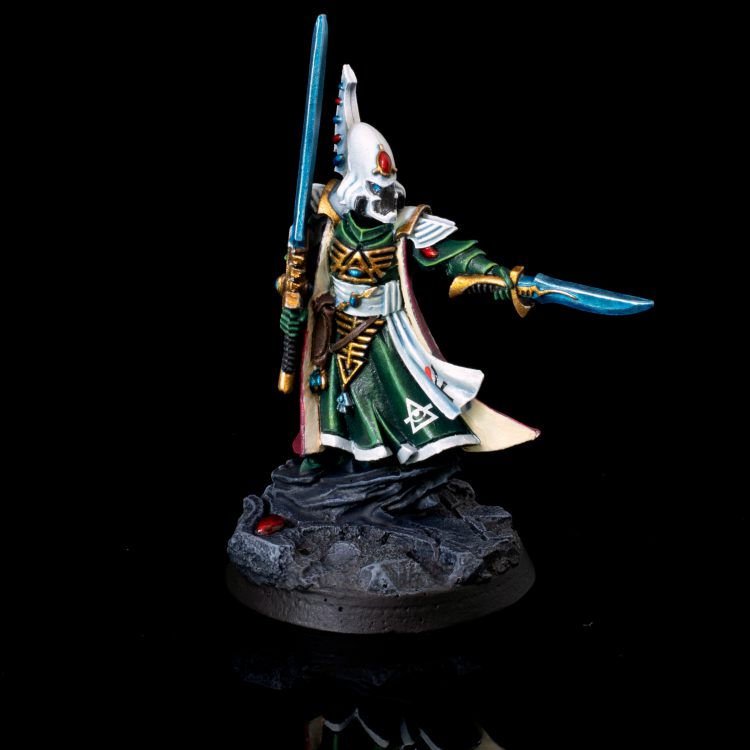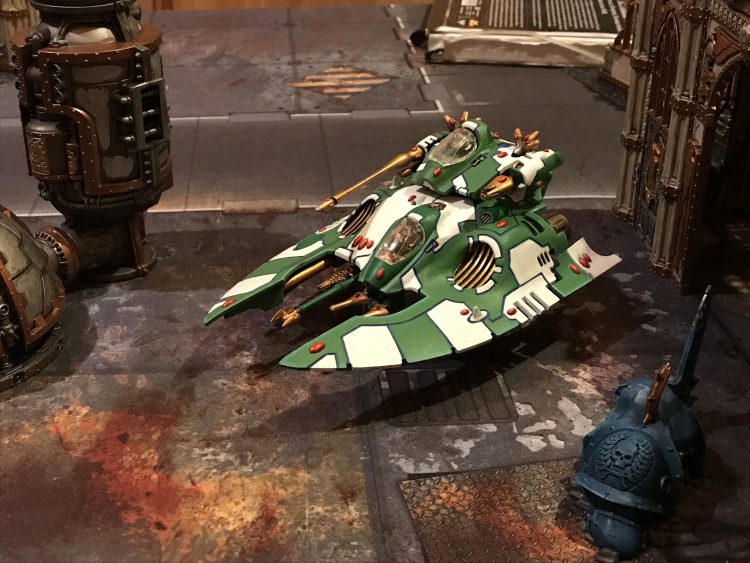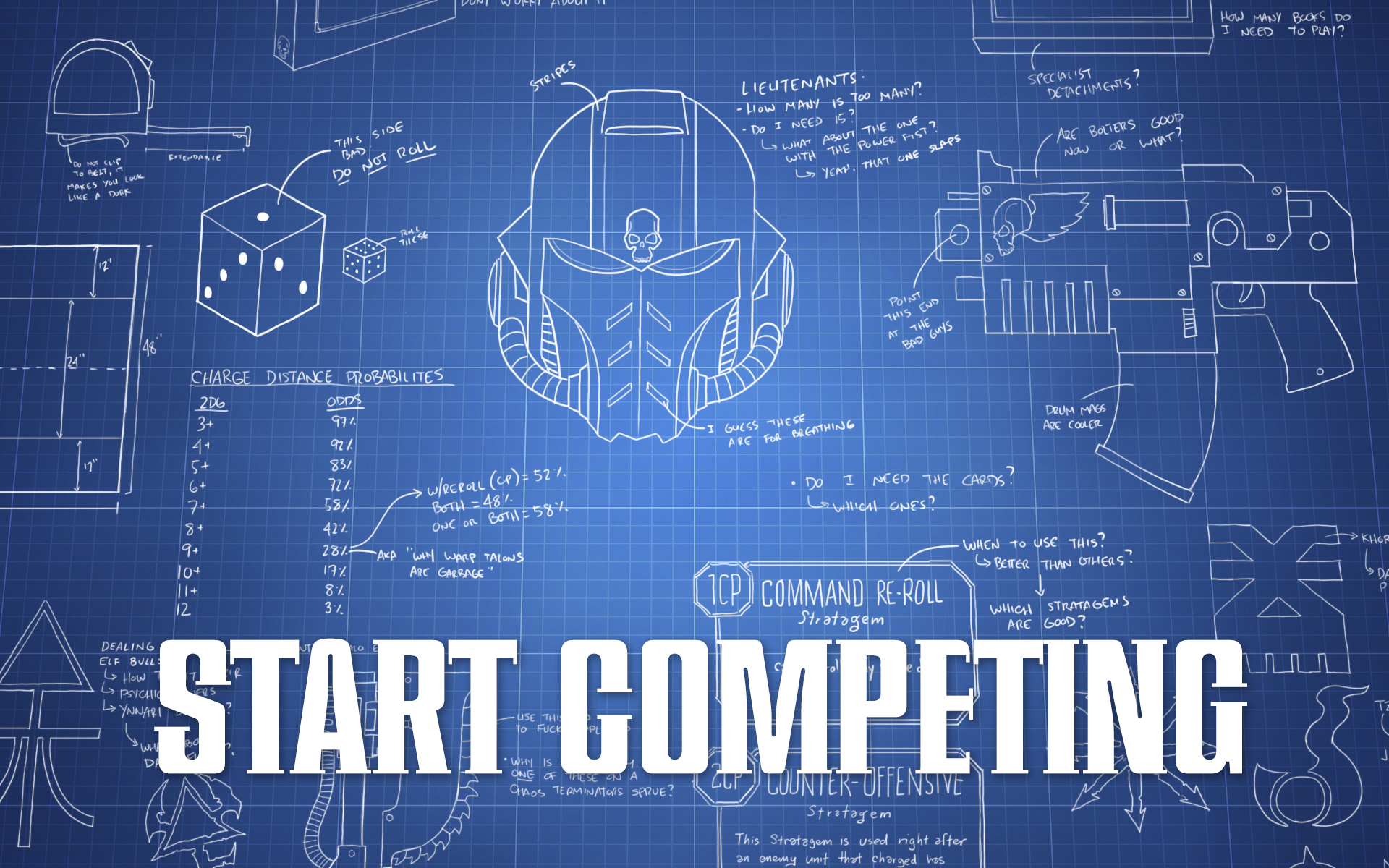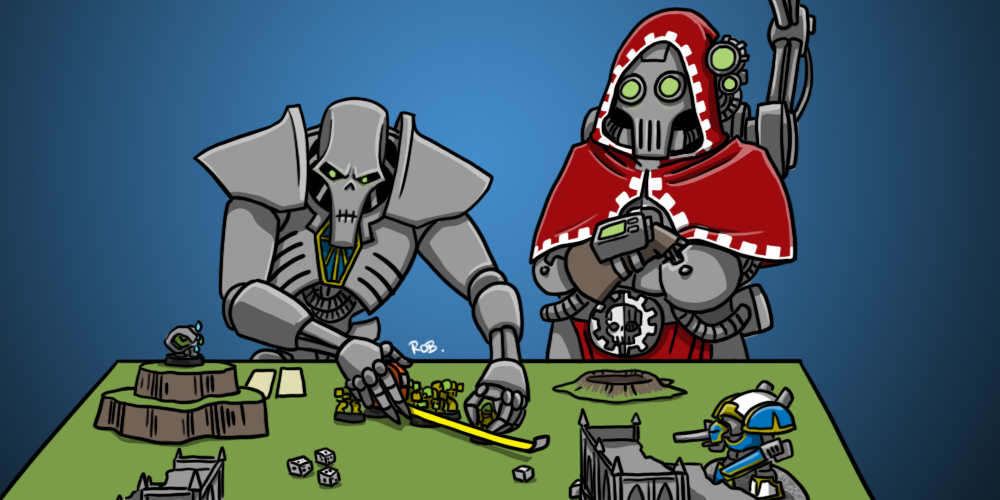As well as updated points and some 2000pts Strike Force missions aimed at competitive play, Chapter Approved 2020 brings us something new – a dedicated set of Incursion (1000pts) missions designed for competitive play. One of the drives for 9th edition appears to be to try and provide full support for as many different kinds of game as possible while maintaining a cohesive feel, and tailored missions for each size of game are a part of this, also appearing in the rulebook. Competitive play has historically tended to unify around either a single game size or a small handful that are at least close to one another. For the majority of 8th edition 2000pts play was dominant with occasional 1750pts events popping up, and there wasn’t generally a need for separate missions to handle those two sizes. The differences between 1000 and 2000pts is much more substantial, however, so for there to be any chance of tournament play at the smaller game size taking off as a competitive format Games Workshop have correctly identified that it needs some dedicated support.
While I don’t think they’ll ever displace 2000pts events as the “main” competitive scene, in the abstract I’d be very in favour of 1000pts being a real, popular format. Between the shorter game length and the substantially reduced space requirements, they would open up the possibility of hosting a tournament to a much wider spread of organisers, and raise the tantalising prospect of being able to smash out a four-round, 16-player event with a single, clear winner in a single day. The community clearly isn’t going to arrive at this by itself though, as there was nothing stopping this being tried in 8th Edition, so some strong incentives, preferably good gameplay, are needed to make this prospect a reality.
That’s what these missions set out to accomplish, and I think it’s fair to say the results are mixed. On the upside, there’s definitely some things to like here, and some design decisions that show an awareness of some of the challenges that will arise with smaller games. The decision to keep the same set of Secondary objectives also holds up surprisingly well. On the downside, there is a frankly baffling failure to properly lean-in to the recommended table size for Incursion games in the map design, and I’m still up in the air on whether the design here does enough to address the inherant challenges of balancing 1000pts play. Let’s dig in!
How the Missions Work
Mission Structure
The good news, up front, is that if you’ve been keeping up with our coverage of the new missions thus far there aren’t any big surprises here – the overall structure of the Incursion missions is identical to the Strike Force missions, with the only exceptions being:
- The recommended minimum table size is 30″x44″ rather than 44″x60″.
- You are limited to two of each non-Troops/Transport datasheet rather than three.
- Six starting CP pre-list building rather than twelve.
To save you from having to click back to one of our previous reviews, the summary is as follows:
- Game Structure and Winning
- The winner is determined by a Victory Point (VP) score out of 100, with:
- A maximum of 45VP for achieving Primary Objectives
- A maximum of 45VP for achieving Secondary Objectives.
- 10VP for having your army painted to a battle forged standard.
- All missions last five turns.
- The winner is determined by a Victory Point (VP) score out of 100, with:
- Deployment and First turn
- All missions use fixed deployment zones and objective placement.
- All missions use alternating deployment followed by a random roll off for first turn.
- All decisions about reserves, deep strikers and who is riding transports are made prior to deployment.
- Primary Objective Scoring
- All missions allow you to score primary objectives at the end of your second through fifth command phases (i.e. “start of turn” in 8th parlance).
- You can score a maximum of 15VP from primary objectives each turn, capped by the 45VP game-long total.
- There are two versions of primary scoring, one used by six of the missions and one used by three.
- Secondary Objective Scoring
- Each player selects three secondary objectives pre-battle, which can be scored for up to 15VP each.
- There are five secondary objective categories (each with three or four choices) and you can only select one from each category.
- Each mission provides an additional secondary objective choice that is separate from the categories.
- Secondary objectives have a variety of scoring conditions, often involving Actions (things that units can spend their turn doing instead of pretty much anything else) or Psychic Actions (things psykers can attempt instead of casting).
While the structure is the same, the devil is in the details, and both in terms of mission specific rules and secondaries the dynamics change a bit, the latter in spite of the non-mission secondaries being chosen from the same lists.
Mission Special Rules

In the Strike Force GT missions, mission-specific special rules were reduced compared to the ones in the rulebook, with the objective maps and mission secondaries being the main differentiator. For Incursion that isn’t true – seven of the nine missions have some sort of special rule that changes up the game to a greater or lesser extent. This is, to my mind, a good thing. That might sound weird given I praised the removal of mission-specific rules from the Strike Force GT missions, but I think this sort of rule has much more of a place in smaller games. With fewer points to spend, and a major incentive towards a “box-ticking” style of list design, games risk becoming pretty samey without something to mix the dynamics up.
I’m still not 100% sold on the return of a few mechanics that punish certain kinds of unit, such as the return of a mission that doesn’t allow you to use any abilities that let units deploy outside of your own deployment zone, but there’s arguably more incentive to introduce a drawback for skewing heavily to some kinds of effect, as it’s more likely that some armies just straight up can’t easily deal with them.
On balance, I think this was the right choice here, and should end up making these games more interesting.
Secondary Objectives

Something that tends to demonstrate good game design is using the same set of mechanics in different contexts to generate quite different results and incentives, and I think this is somewhere that the Incursion missions succeed. The Core Secondary Objective list available to players is exactly the same as in Strike Force, but plays quite differently in practice.
Mostly, this is down to the fact that the Secondaries based around killing specific targets will very rarely be able to be maxed in Incursion. Where plenty of 2000pts lists will provide enough targets to score one of these to 15VP, being able to do so at 1000pts will be extremely rare even just based on looking at lists in a vacuum, and once you factor in the extreme incentive to not build a list vulnerable to this, should almost never come up.
Combined with the risk of straight-up running out of units to accomplish some of them, and the smaller table making it easier for opponents to interfere with others, I would expect the average score from each Secondary objective to go down quite a bit compared to Strike Force games. That seems to be assumed in the design of mission secondaries as well, which with a couple of exceptions seem a bit less easy to max out than the ones from the Strike Force missions as well.
All this changes the incentives when picking Secondaries quite a bit. I would say that in general, a Secondary that you can reliably score for 10-12VP becomes much more valuable, and incremental ones like Psychic Interogation where you’ll probably score at least 9VP, but might struggle to get all the way to 15, a lot better.
Much like the high difficulty of the Secondaries in general, that’s going to feel weird to start out with coming from 8th, but once you adjust it’s an interesting shift. Combined with the difference in board size, it also makes some choices that won’t see too much use in Strike Force a bit more interesting. Deploy Scramblers, which is quirt reliable but capped at 10VP, is a much better option here, while the fact you often have less far to travel means Linebreaker should see more use too.
The ones you really need to think about when building lists, however, are Grind them Down (kill more) and Domination (hold more). These are the two that a skilled player can probably still push to 15 if the game goes there way, so you want to avoid being too vulnerable to losing out bad on either of them, and ideally able to contest them yourself.
Secondaries are a win here for me. To have a system that re-uses content from a different game size that not only works but generates interesting new dynamics is a significant accomplishment – great job.
Map Design
This has been really positive so far, but I’m afraid we’re on to the one thing I don’t like about the Incursion missions and it’s a big one.
Incursion’s recommended minimum table size is 30″x44″, and as discussed in the introduction, this arguably represents a big part of why there might be a niche for 1000pts events. With the same amount of space and terrain, the smaller table size lets you run an event with twice the tables and twice the participants – for TOs with an existing setup, you can literally tape out two 30″x44″ maps on a 6×4 battle mat with a decent 12″ gap between them. It also adjusts the game to better fit the likely size of armies – a full size table can feel sparse with only 1000pts down, especially with the requirement to occupy multiple parts of the board.
With all that in mind, the Incursion mission maps should really lean-in ot the smaller boards and they just don’t.
The setup diagrams for these missions are all still drawn at the same measurement scale as the Strike Force ones – which you can clearly tell, because there’s a visible grid on them with each square being 1″. There are the same number of squares on the Incursion diagrams, and where lines with defined distances are drawn that scale holds.
“Aha”, I hear you say, “but all the measurements are from the centre, so they work on the smaller board sizes.”. Well…kind of? It is technically true that all of the deployment maps fit on a 44×30 board, but take a look at where the objectives end up when I followed the map for the very first Incursion mission in the book, Crossfire:
 This map has a 9″ bubble in the centre, and then an additional 12″ on top of that that you offset the objectives by along the long edge. Given that we’ve got 44″ total to play with that puts them a mighty 1″ from the short table edge.
This map has a 9″ bubble in the centre, and then an additional 12″ on top of that that you offset the objectives by along the long edge. Given that we’ve got 44″ total to play with that puts them a mighty 1″ from the short table edge.
My honest reaction to looking at that picture is just to ask – “really?”. Is that really the intent here? 9th is all about encouraging dynamic showdowns in the mid-board, so having the very first mission in the pack have the objectives banished to the fringes just seems bizarre. You basically see similar weird impacts on quite a few of the maps that are either “Dawn of War” or “Search and Destroy” style, with objectives ending up mere inches away from the table edge, and on the DoW maps you also end up with tiny 6″ deployment zones.
I’m honestly at a loss of what to make of this, and it seems like a massive missed opportunity. I can appreciate that even while playing with smaller armies you do still want to preserve a similar distance between them as you see in Strike Force, as reducing that by too much makes some abilities distinctly oppressive. However, that sort of problem is exactly why you have a dedicated set of missions for this game size, and the way around it isn’t to just shrug and have weird maps, it’s to tailor for it. Use more “Hammer and Anvil” style deployments, do more stuff like the Centre Ground mission which uses a deployment zone setup not seen in 8th, go wild and split the deployment zones – you have options.
The whole point of having a separate mission set for Incursion is that you can break out from some of the constraints of Strike Force and do stuff specifically aimed at smaller games, and it seems like an extreme missed opportunity that these just don’t. It also raises some questions about how they were playtested – was that done on full size tables, the recommended minimum, or something in-between? For the rulebook missions I can see the argument of assuming most people just play on a full size table all the time, but these are meant to be tuned and tailored competitive missions – and surely how big the table is is something you can dictate there? As I said at the start, I’m genuinely interested in seeing this format take off as something people want to play, but I see the smaller boards as a key part of that, and I have to wonder how many players will look at the fact that the very first mission here looks bizarre on the small table size and just not bother to try.
Realistically, and I hope this is what happens in (presumably) next year’s mission pack, these should either have a set of deployment zones tailor made for the the smaller board size, or each of these missions should have a separate map supplied for 30×44 and 44×60. I’m honestly just frustrated by this – I’m otherwise extremely positive on the Incursion missions and want to try them seriously, and it’s sad to see them held back by this one weird decision.
Building Incursion Armies

One of the challenges you have to deal with when trying to make 1000pts games work is that, bluntly, at smaller game sizes the incentive to build lists like a total bastard is massive. Players are much more limited in how many different types of threats they can build answers to into their lists, meaning that sometimes skewing your army towards certain kinds of unit (usually heavier stuff) can be hugely advantageous, as your opponent might just not be able to deal with it, handing you a free win. Glass cannon style units also tend to be quite a bit better, because if they drop in and make their points back there’s a much higher chance that the damage they’ve inflicted leaves an opponent without the tools to respond, creating a snowball effect that can be difficult to come back from. Finally, any faction having access to fast horde units risks being an insurmountable threat if they get the first turn and just steamroll the game.
Realistically, 1000pt games have always relied a bit more on a social contract to get players to bring lists that don’t generate horrendous play experiences for one side. However, a lot of elements of 9th Edition and the missions definitely pull in the right direction to deal with the extremes here. In no particular order:
- Horde coherency changes reduces the amount of space they can dominate.
- Blast makes it easier to adapt to hordes while maintaining anti-tank capability.
- The change to Look Out Sir from 8th’s character targeting reduces the scope to build abusive, character centric lists.
- The shorter game length reduces the time for an advantage to snowball.
- The lower CP cap in Incursion heavily motivates you to stick to one detachment, reducing the slots you have to build skew lists.
- Primary scoring requires a force that can spread out to multiple objectives.
- Removal of free fall back and shoot for FLY gives more options against some lists.
That’s all good stuff, and I think out of the gate there’s a substantailly better chance of this working in 9th than there ever was in 8th. I do think this is one of the places where the big miss on the map design really hammers home though – both extremely shallow DoW deployment zones and tiny box corners in the S&D equivalents are needlessly vulnerable to horde bulldozing, where the Hammer and Anvil and angled corner ones give the defending player more options to work with. That’s only one downside among a lot of positives though.
Even with the changes though, some things are naturally more valuable. These include:
- Flexible units – anything that can put out reasonable firepower both against hordes and vehicles is worth its weight in gold.
- Highly durable units – the kind of thing that takes a whole Strike Force army a turn to put in the bin is obviously much better if only an Incursion army is shooting at them!
- Anything that can substantially spike its damage output at a cost – doing so tends to have a higher payoff.
- Anything that punishes your opponent for not fully finishing them off gets better – think Necrons, Cultists and Ork Boyz.
At a higher level, the design of the 9th Edition missions also means that there are some boxes I’m aiming to tick when building an army for Incursion. I want:
- At least two durable things I can move onto objectives turn 1.
- At least one nasty melee threat that can flip an objective to my control when needed.
- A reasonable plan for killing two Knights – Warden, Errant, Warglaive is basically your baseline gatekeeper list in Incursion.
- As flat a target profile as I can present turn 1, maximising the chance of getting some “skew” benefits.
- One detachment unless I have a very compelling reason otherwise.
An example of how I’d bring that together is as follows:
Craftworlds Patrol – Expert Crafters/Masters of Concealment
HQ
Farseer – Doom, Executioner, Smite, Faolchu’s Wing, Warlord – Fate’s Messenger – 115
Warlock Skyrunner – Protect/Jinx, Focus Will – 65
Troops
Dire Avengers x5, Bladestorm, Extra Shuriken Catapult – 70
Dire Avengers x5, Bladestorm, Extra Shuriken Catapult – 70
Elites
Wraithblades x6, Axes/Shields – 240
Heavy Support
Falcon, Aeldari Missile Launcher – 135
Falcon, Aeldari Missile Launcher – 135
Dedicated Transport
Wave Serpent, Twin Aeldari Missile Launcher – 170
This is both a decent example of a list I think would do well in these missions and a reasonable illustration of the fact that while 9th does a better job of policing some of the nonsense you can pull off in listbuilding, it’s far from perfect. This probably doesn’t look unreasonable to anyone who’s started exploring how they’d skew their own faction’s roster for 1K, but if you’re coming fresh it’s probably made you throw up in your mouth a bit. The only things an opponent can shoot at turn 1 are tank hulls, and Lightning Fast can be popped against the nastiest single gun, it’s extremely mobile and has a reasonable spread of shooting to go after targets both big and small, with Expert Crafters letting it overperform massively against a lot of things. Finally, if the Wraithblade blob gets out of their ride and picks up Protect, they’re going to be a complete nightmare to shift while being able to put a brutal amount of hurt into anything they run into.
There’s bound to be more degenerate stuff you can do, and you might find Shining Spears perform better in the Wraithblade slot, but much more so than in Strike Force I want to skew towards a really durable melee threat and the Blades are just that bit hardier.
Even this list, which is reasonably aimed at being an all-comers list, probably struggles against some of the skew you can do. Orks can put down 90+ T4 bodies and still have the points for character support. As aforementioned, you can face down two Questoris Knights and an Armiger. I can’t be bothered to math out how many Nurglings you get at 1000pts, but I’m sure it’s too damn many. Some of these lists might stumble when asked to compete on some of the missions, but I think the risk that some sort of extremely tough to beat skew build would emerge at 1000pts is a real risk, and with balancing being tuned for 2000pts, whether there would be a good way to deal with it is up in the air.
Overall
I’m a fan of seeing 1000pts games supported in the GT2020 pack, and strongly suspect they combine with 9th Edition’s core improvements to create a better environment for smaller games than we’re used to. Whether that’s enough to get people playing them, especially in concert with the bizarre unforced error on maps remains to be seen. I do hope that if we continue to see Incursion competitive content produced it more clearly leans in to the difference in table and game size, as I think that’s one of its biggest strengths. I’m also really interested to see, if the format does pick up any interest, what the armies look like – it’s really hard to tell on paper if 9th Edition does enough to dial in the most egregious builds. Ultimately though – more ways to play good, balanced 40K is something I’m on board with, and I like enough of what I’m seeing here to give it an overall thumbs up on everything except the maps.
Wrap Up
If you have any thoughts, comments or suggestions give us a shout at contact@goonhammer.com, and if you’ve missed out on any of our 9th Edition coverage make sure to check out our dedicated page for it.



